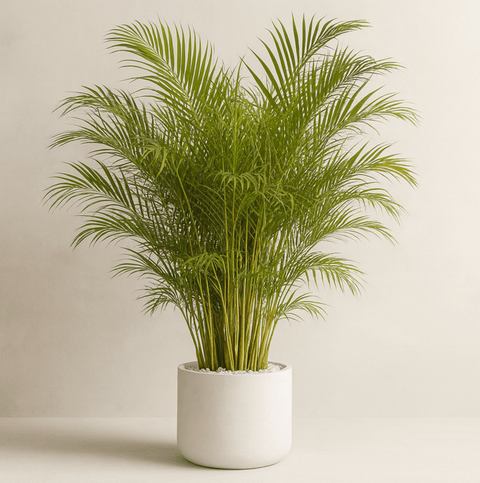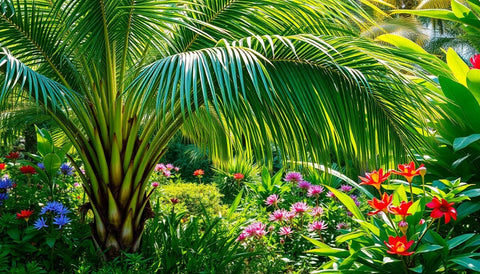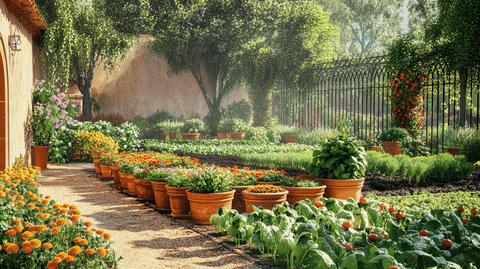Introduction: The Allure of Star Jasmine
Star jasmine (Trachelospermum jasminoides) is cherished by gardeners and plant enthusiasts alike for its captivating beauty and enchanting fragrance. Native to Asia, this versatile plant is renowned for its exquisite star-shaped flowers that can elevate the aesthetic appeal of any space, whether it's used as a climber along trellises, a ground cover, or even a bonsai-style shrub. Its lush, glossy green foliage combined with its profuse blooms make it a popular choice for home gardens across various climates.
At Plantology, we understand the allure that star jasmine holds for plant lovers and new gardeners. This comprehensive guide aims to be your go-to resource for understanding and nurturing this plant to its full potential. Whether you're planting star jasmine for the first time or looking to enhance your existing garden, we're here to help you every step of the way.

Understanding Star Jasmine
2.1. Botanical Background
Originating from the subtropical regions of Southeast Asia, star jasmine's natural habitat extends from China to Japan. This evergreen vine is often mistaken for a true jasmine due to its similar name and scent. However, it belongs to the Apocynaceae family rather than the Oleaceae family, which contains true jasmines. Despite this botanical distinction, its fragrance and aesthetic appeal have garnered it the same renown as its namesakes.
Star jasmine thrives in warm climates and can grow up to 20 feet long, making it an excellent choice for covering walls, fences, and pergolas. Its adaptability and resilience have contributed to its widespread cultivation around the world.
2.2. Physical Characteristics
Star jasmine is characterized by its glossy, dark green leaves, which provide a stunning backdrop to its small, star-shaped white flowers. These blooms typically appear in late spring and last through the summer, exuding a sweet scent that is beloved by many. As a fast-growing climber, it can also be pruned into a shrub, offering versatility in garden design.
The Essentials of Star Jasmine Care
3.1. Ideal Growing Conditions
3.1.1. Light Requirements
Star jasmine thrives best in full sun to partial shade. It requires at least 4-6 hours of sunlight daily to support flowering and overall growth. In hotter climates, it can benefit from some afternoon shade to protect against intense sunlight, which can scorch its leaves. For those looking to grow star jasmine indoors, place it near a bright window with plenty of indirect light.
3.1.2. Temperature and Humidity
As a subtropical plant, star jasmine prefers warm, humid conditions. It thrives in temperatures ranging from 60°F to 85°F (15°C to 29°C). Although it can tolerate mild frost, temperatures below 20°F (-6°C) may damage the plant. In regions with harsh winters, consider growing star jasmine in pots for easy relocation indoors during colder months.
3.2. Soil and Planting Tips
3.2.1. Soil Preferences
Star jasmine flourishes in well-draining soil rich in organic matter. A slightly acidic to neutral pH (between 6 and 7) is ideal for promoting healthy growth. If planting in a garden bed, consider amending heavy clay or sandy soils with compost to enhance drainage and nutrient availability.
3.2.2. Planting Directions
When planting star jasmine, consider the space and support it will need to climb. If planting in a garden bed, dig a hole twice as wide and the same depth as the root ball. Gently loosen the roots before placing the plant in the hole, backfill with soil, and water thoroughly to eliminate air pockets. For those limited on space, growing star jasmine in a pot with a sturdy trellis can provide a beautiful vertical element with easy mobility.

Watering and Fertilizing
4.1. Watering Needs
Consistent watering is key to maintaining healthy star jasmine. Regularly water your plant, allowing the soil to dry out slightly between waterings. Avoid waterlogging, as it can lead to root rot. During hot, dry spells, increase watering frequency to keep the plant hydrated. Mulching can help retain soil moisture and regulate soil temperature.
4.2. Fertilization Routine
Fertilizing star jasmine is essential to promote vigorous growth and prolific blooming. Apply a balanced, slow-release fertilizer in early spring and mid-summer to provide necessary nutrients. You can also use a liquid fertilizer every four to six weeks during the growing season for optimal results. Be cautious not to over-fertilize, as this can lead to excessive foliage growth at the expense of blooms.
Pruning and Maintenance
5.1. Pruning Techniques
Regular pruning helps maintain the desired shape and size of star jasmine while encouraging flowering. Prune your plant in late winter or early spring before new growth begins. Focus on removing dead or damaged stems, shaping the plant, and thinning crowded areas to improve air circulation. You can also trim back any overly long stems to promote denser growth.
5.2. Dealing with Pests and Diseases
5.2.1. Common Pests
Star jasmine is relatively pest-resistant, but it can occasionally fall prey to aphids, spider mites, and whiteflies. Regularly inspect your plant for signs of infestation, such as discolored leaves or webbing. Treat with insecticidal soap or horticultural oil as needed, ensuring that you protect your plant from potential harm without resorting to harsh chemicals.
5.2.2. Disease Prevention
Diseases affecting star jasmine are often related to fungal infections caused by overwatering or poor air circulation. Ensure that you are watering appropriately and promoting airflow by spacing plants adequately and pruning dense growth. Fungicidal sprays can be used as a preventative measure or to treat existing issues.

Landscape Uses and Companion Planting
6.1. Creative Landscaping Ideas
One of the most attractive aspects of star jasmine is its versatility in the landscape. Use it as a climber to cover unsightly fences or walls, allowing its fragrant blooms to create a stunning natural curtain. It can also serve as a ground cover for larger areas, ensuring a lush, green carpet throughout the seasons.
For smaller spaces, star jasmine can be pruned into a compact shrub or trained on an obelisk trellis for a striking vertical focal point. Consider pairing it with other plants that thrive in similar conditions, such as the Agapanthus Lily of the Nile Blue, to create a cohesive and vibrant garden display.
6.2. Companion Plants
When planning a garden with star jasmine, consider pairing it with compatible companions that complement its growth habits and light requirements. The Agave Desmettiana Variegata is an excellent choice, providing contrast with its unique foliage and maintaining the theme of subtropical elegance. Similarly, the Alexander Palm adds vertical interest and architectural form when planted alongside jasmine.
Propagating Star Jasmine
7.1. Methods of Propagation
7.1.1. Propagation by Cuttings
One of the simplest ways to propagate star jasmine is through stem cuttings. Select healthy, non-flowering stems and cut 4-6 inch sections just below a leaf node. Remove the lower leaves and dip the cut end in rooting hormone before placing it in a pot filled with well-draining soil. Keep the cuttings moist and in a warm, humid environment, and roots should develop in 4-6 weeks.
7.1.2. Propagation by Layering
Layering is another effective method, particularly for established plants. Select a low-growing stem and bend it to the ground. Make a small wound on the section of the stem that will be buried, and secure it with a landscape pin or by covering it with soil. In a few weeks, roots should form, and the new plant can be detached from the parent.
Conclusion: Celebrate Your Star Jasmine Success
Growing star jasmine is a rewarding endeavor that not only enhances the beauty of your garden but also fills it with a delightful fragrance. By following the guidelines outlined in this guide, you're well on your way to cultivating healthy and vibrant plants that will thrive for years to come.
At Plantology, we're committed to helping you bring your garden dreams to life. Explore our diverse plant selection, including the exquisite Adonidia Palm Double and more, to find the perfect companions for your star jasmine. Visit Plantology today to discover a world of possibilities for your outdoor oasis.
The Environmental Benefits of Star Jasmine

8.1. Biodiversity Contribution
Beyond its ornamental value, star jasmine offers a host of environmental benefits, particularly when it comes to supporting local biodiversity. The sweet aroma of its blooms attracts a variety of pollinators, including bees, butterflies, and occasionally hummingbirds. This makes it an excellent addition to pollinator gardens, aiding in the conservation of these vital species.
Incorporating star jasmine into your green spaces not only provides food and habitat for pollinators but also contributes to the overall ecological health of the area. By enhancing plant diversity, star jasmine helps create a more resilient and balanced ecosystem within your garden.
8.2. Erosion Control
Star jasmine serves as an effective natural solution for erosion control, particularly when used as a ground cover. The plant's dense foliage and robust root system work together to stabilize soil and prevent erosion on slopes or in areas prone to water runoff. By anchoring the soil, star jasmine reduces the risk of landslides and helps maintain the quality and fertility of the soil.
Furthermore, its adaptability to various soil types makes it a versatile choice for tackling erosion across different environments. Whether you're dealing with sandy soils or nutrient-rich loam, star jasmine can effectively reduce erosion and promote a healthier landscape.
Cultural and Symbolic Significance
9.1. In Traditional Practices
Star jasmine has played a role in various cultural and traditional practices, particularly in Asia, where it originates. In countries like China and Japan, the plant is often associated with purity and elegance, symbolized by its pristine white flowers. It is not uncommon to find star jasmine used in traditional wedding garlands and religious ceremonies, both for its fragrance and its symbolic meaning.
Moreover, star jasmine's fragrance has been valued in the art of perfumery, used historically in the creation of scented oils and perfumes. The plant's association with beauty and serenity makes it a popular component in creating peaceful garden spaces for meditation and reflection.

FAQs and Troubleshooting Guide
10.1. Frequently Asked Questions
10.1.1. Can star jasmine grow indoors?
Yes, star jasmine can grow indoors, provided it receives ample sunlight and proper care. Place it near a bright window to ensure it gets at least 4-6 hours of indirect light daily. Additionally, maintaining appropriate humidity levels and air circulation indoors will contribute to its health and flowering.
10.1.2. How can I encourage more blooms?
To encourage more blooms on your star jasmine, ensure it receives adequate sunlight and nutrients. Pruning after flowering in the summer can promote new growth and blooms for the following season. Also, avoid over-fertilizing with nitrogen-heavy products, as these stimulate foliage growth at the expense of flowers.
10.2. Troubleshooting Common Problems
10.2.1. Yellowing Leaves
Yellowing leaves can result from overwatering, nutrient deficiency, or insufficient light. Check your watering schedule and ensure the soil is well-draining. Furthermore, consider applying a balanced fertilizer to address potential nutrient shortages. If the plant is indoors, reposition it to receive adequate sunlight.
10.2.2. Stunted Growth
Stunted growth may be indicative of cramped roots if the plant is pot-bound or lacking sufficient nutrients. Repot your star jasmine in a larger container to give the roots more space. Incorporate slow-release fertilizer into the soil to boost growth, and verify that it's receiving the appropriate amount of light and water.

Conclusion: Nurturing a Timeless Garden Beauty
Star jasmine not only elevates the aesthetic and fragrant appeal of your garden but also plays a part in fostering biodiversity and environmental health. By following this comprehensive guide, you unlock the potential to not only cultivate a robust and blooming star jasmine plant but also contribute to a flourishing garden ecosystem.
As you admire the glossy foliage and intoxicating blooms, remember that successful gardening involves patience, observation, and passion. Whether you’re an experienced gardener or a novice, the joy of nurturing star jasmine is a rewarding experience that underscores the beauty of nature and its intricate workings.
At Plantology, we're dedicated to supporting your gardening journey every step of the way. Ensure you visit Plantology to explore a rich variety of garden companions and find inspiration for your green oasis. Dive into the world of plants with us, and let’s grow together.























Comments (0)
There are no comments for this article. Be the first one to leave a message!